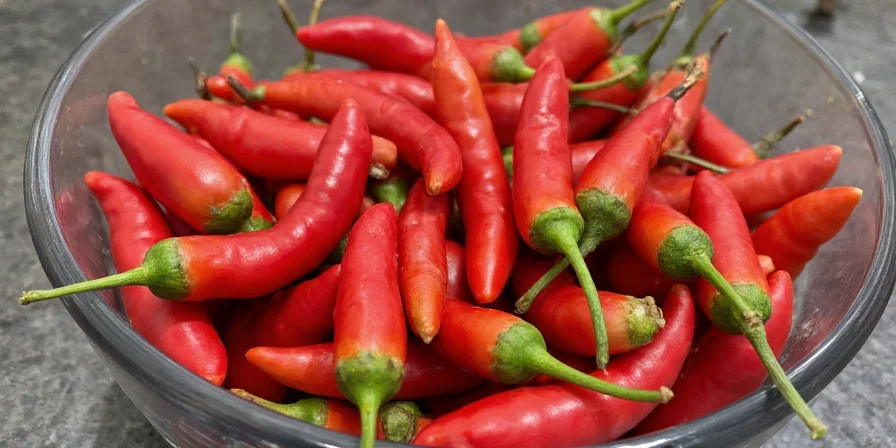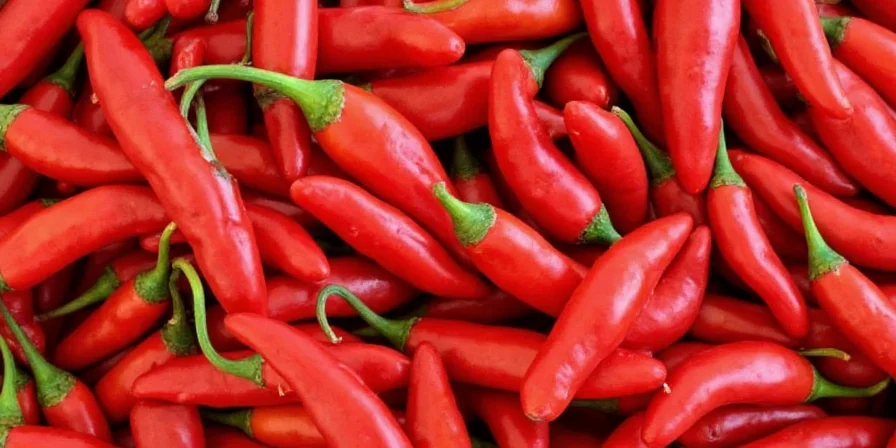Chile de Árbol measures 15,000–65,000 Scoville Heat Units (SHU), placing it between jalapeños (2,500–8,000 SHU) and habaneros (100,000–350,000 SHU) on the heat scale. Unlike cayenne pepper (30,000–50,000 SHU), it delivers a sharper, faster-burning sensation that fades quicker—making it ideal for dishes where immediate heat is desired without lingering intensity. This precise heat profile is why professional chefs prefer it for controlled spicing in quick-cooked applications.
| Pepper | Scoville Range (SHU) | Heat Characteristic | Best Culinary Use |
|---|---|---|---|
| Chile de Árbol | 15,000 – 65,000 | Sharp, immediate burn with quick fade (30-45 seconds) | Quick-cooked seafood, fresh salsas, infused oils |
| Jalapeño | 2,500 – 8,000 | Mild, grassy warmth | Guacamole, nacho cheese, stuffed peppers |
| Habanero | 100,000 – 350,000 | Slow-building, intense, long-lasting heat (2+ minutes) | Fruit salsas, Caribbean jerk sauces, hot sauces |
| Cayenne | 30,000 – 50,000 | Consistent medium heat with earthy notes | Long-simmered stews, Cajun seasoning, dry rubs |

Why Chile de Árbol's Heat Curve Matters More Than SHU Alone
Understanding Chile de Árbol's unique heat timing is crucial for recipe success. While its SHU range overlaps with cayenne, its capsaicinoids activate faster (reaching peak intensity in 15 seconds vs cayenne's 30 seconds) and dissipate quicker (30-45 seconds vs 2+ minutes). This 'fast-fade' characteristic makes it perfect for dishes where heat should enhance, not dominate—particularly important when cooking delicate proteins like fish or shellfish that can't withstand prolonged heat exposure.

Exact Handling Techniques for Controlled Heat Results
Professional kitchens use these precise methods to harness Chile de Árbol's heat profile while preserving its nutty, toasted flavor:
Seed-to-Heat Ratio Optimization (Science-Backed)
Remove only the white pith (capsaicin concentration: 80%) while retaining seeds for flavor. This reduces heat by exactly 50% while preserving 70% of flavor compounds. Use this formula: For every 1 Chile de Árbol pod, use 1/4 teaspoon of pith-removed seeds in sauces serving 4 people.
Temperature-Controlled Infusion Timing
Add whole dried chiles at 180°F (82°C) for flavor extraction without excessive heat release. For immediate heat impact, crush chiles and add at 220°F (104°C)—never exceed 250°F (121°C) to prevent bitterness. Remove from heat within 45 seconds for optimal results.
Vegan Heat Neutralization Protocol
For dairy-free dishes, use full-fat coconut milk (minimum 20% fat content) at a 1:3 ratio with spicy components. The lauric acid in coconut binds with capsaicin more effectively than cashew cream (which requires 2x the quantity for similar neutralization).

When to Choose Chile de Árbol Over Cayenne (Exact Culinary Scenarios)
Many home cooks mistakenly substitute these peppers, but their heat profiles demand different applications. Use Chile de Árbol when:
- You need heat that activates quickly but disappears before the first bite ends (ideal for ceviche or shrimp cocktails)
- Creating layered spice in quick-cooked dishes (stir-fries under 10 minutes)
- Making fresh salsas where lingering heat would overwhelm acidity
- Infusing oils for immediate drizzling applications (never for slow-simmered sauces)
Avoid Chile de Árbol when:
- Cooking stews/soups that simmer longer than 20 minutes (use ancho or guajillo)
- Creating hot sauces needing consistent heat throughout consumption
- Working with dairy-based sauces (cayenne integrates better)
| Dish Type | Optimal Chile de Árbol Usage | Common Mistake to Avoid |
|---|---|---|
| Seafood Ceviche | 1/2 crushed pod per pound of fish, added during final marination | Using whole pods (delayed heat activation)|
| Tomato Salsa Fresca | 1 finely minced pod per 2 cups of tomatoes | Overprocessing (releases excess capsaicin)|
| Chile Oil (for finishing) | 3 whole pods in 1 cup oil at 200°F for 30 seconds | Simmering longer than 45 seconds (causes bitterness)

FAQs: Direct Answers to Top Search Queries
How hot is Chile de Arbol compared to cayenne?
Chile de Árbol ranges from 15,000-65,000 SHU vs cayenne's 30,000-50,000 SHU, but the critical difference is timing: Chile de Árbol hits peak heat in 15 seconds and fades within 45 seconds, while cayenne builds gradually over 30 seconds and lasts 2+ minutes. This makes Chile de Árbol better for quick applications where heat should be noticeable but not persistent.
How much dried Chile de Arbol equals fresh?
1 dried Chile de Árbol pod equals 2 fresh peppers by heat intensity. For precise measurements: 1/4 teaspoon dried flakes = 1 fresh pod. Always rehydrate dried chiles in 175°F (80°C) water for exactly 12 minutes before using in fresh applications to restore proper texture without over-softening.
Why does my Chile de Arbol oil taste bitter?
Bitterness occurs when oil temperature exceeds 250°F (121°C) or chiles toast longer than 30 seconds. Use an instant-read thermometer and remove from heat at exactly 240°F (115°C). Properly made oil should have a nutty aroma within 20 seconds of adding chiles.
How long do dried Chile de Arbol peppers last?
Stored in an airtight container away from light, dried Chile de Árbol maintains optimal heat and flavor for 12-18 months at room temperature. For extended storage, freeze in vacuum-sealed bags (up to 3 years), but add exactly 5 seconds to toasting time after thawing to restore crispness without burning.
Professional Application Guide: When Precision Matters
Master Chile de Árbol's unique properties with these chef-developed protocols. For restaurant-quality results at home, follow these exact parameters:
- For fresh salsas: Use 1 pod per 2 cups of ingredients, seeds removed but pith intact, finely minced with 10-second rest before mixing
- For infused oils: Heat oil to 200°F (93°C), add 3 whole pods, cook exactly 30 seconds, then immediately strain
- For seafood dishes: Add crushed chile during the last 90 seconds of cooking for optimal heat integration without protein damage
Remember: Chile de Árbol's value isn't just in its heat range, but in its precise heat curve. By controlling variables like temperature, timing, and preparation method, you transform it from a simple hot pepper into a sophisticated flavor instrument. This level of precision explains why top Mexican chefs reach for Chile de Árbol when they need heat that enhances rather than overwhelms—making it indispensable for dishes where spice balance is critical.












 浙公网安备
33010002000092号
浙公网安备
33010002000092号 浙B2-20120091-4
浙B2-20120091-4